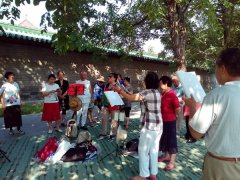Feature: China's Yi shamans struggle to survive
CHENGDU, June 19 (Xinhua) -- First they stun the rooster with three quick blows using the hilt of a knife, then they slit its throat to slowly release its blood -- this gruesome scene is part of a traditional ritual to pray for a safe journey, and Shama Ligu has performed it many times.
For 27 years, Shama Ligu, 52, has served as a Bimo, a shaman performing sacred rituals for China's Yi ethnic minority. Acting as a intermediary between the human and spirit worlds, the Bimo officiate at holidays, weddings, births and funerals, as well as attending to diseases, blessings, exorcisms and divination.
With thousands of years of history, the Bimo remain indispensable to the Yi people. However, having lost their appeal to the young, such shamanic practices face a daunting future. The Bimo are dying out.
BIMO MATTERS
Shama Ligu is one of two Bimo in Yihai village Liangshan prefecture, southwest China's Sichuan Province. Locked in deep mountains, Liangshan is home to China's largest Yi community.
"Bimo is a wise man and a great helper in our daily lives," says villager Aeryue Zimo. "Without him, my family will be unable to be blessed by the deities and ancestors."
"When an elderly person dies, the Yi minority believe his or her soul can only return home after a Bimo chants scripture," says Li Xuefeng, 35, an ethnic Yi official with the provincial ethnic and religious affairs commission. "Bimo culture is deeply rooted in the rural society of the Yi. I believe as long as the countryside exists, Bimo will never disappear."
Li has been in awe of the Bimo since he was a child, not just because of their religious role, but as they are also masters of ancient Yi language, astrology and history.
"Without the Bimo, the solar calendar of the Yi people would have died, " Li says.
Only male heirs of the Bimo lineage can inherit the role, usually starting to learn aged seven or eight. Although his father and grandfather were both Bimo, Shama Ligu did not consider it until he was 20.
At that time, his mother and eldest brother suffered from prolonged illness and the family's five goats died one after another. A Bimo solved the problems and said that a member of the family should take up the practice. Shama Lagu was chosen.
He followed his teacher, a 75-year-old Bimo, for five years before mastering the basics, often studying until midnight, observing the teacher as he worked.
In the early years of his work, villagers mainly invited Shama Ligu to preside over rites of births, deaths, weddings and funerals, as well as to expel evil spirits. In recent years, many are demanding blessing rituals for those leaving or returning the village.
Today, 80 percent of the villagers work outside of the village, which used to rely solely on potato crops. Last year, the village's annual per capita income was 3,800 yuan (560 U.S. dollars). It was just 500 yuan in 1997.
China's poverty relief campaign has lifted nearly all the villagers from poverty. The local government plans to develop the village as a tourist destination
DYING OUT
Due to the exodus of young people from the countryside, the Bimo are in dire need of successors.
Shama Ligu says that there were five Bimo in the village when he was young. Now there are only two.
Modern education has dealt a blow to the survival of the Bimo.
"While a would-be Bimo should start preparing for the job as a child, Bimo families now prefer to send their children to primary school," says He Gang, a professor of Yi language and culture at Sichuan-based Xichang College."They have long noticed the importance of schooling."
Local schoolchildren are often reluctant to take on the job, as Bimo culture is regarded superstition that flies counter to modern education. Working in the cities is seen as a better choice than being a Bimo.
Strict limits on who can become a Bimo successor have also caused difficulties.
"As rural people have left, the Bimo's business has shrunk. And some have moved to cities," Li says.
Though the job is respectable it is not well-paid, and clients are the ones that price the Bimo's services.
During their free time, Shama Ligu and his wife grow potatoes and corn, which brings the family less than 4,000 yuan last year. They also do odd job to make ends meet.
In the past years, he has borrowed more than 20,000 yuan to pay school fees for his four children, with three entering junior college.
"We can have a rest after they graduate," he says.
A pressing task for the Shama lineage is to find a Bimo successor. The lineage has 10 male members, but none are interested in becoming a shaman.
"My brothers and I have decided that, someone among them, who can't get into college or find a stable job, has to take on the Bimo job," Shama Ligu says.
He Gang has suggested the government take action to protect Bimo culture as modern education means fewer children are likely to take on such folk beliefs.
"Knowledge about the Bimo has been taught by word of mouth. If there is no successor, the Bimo culture will die," He says.















